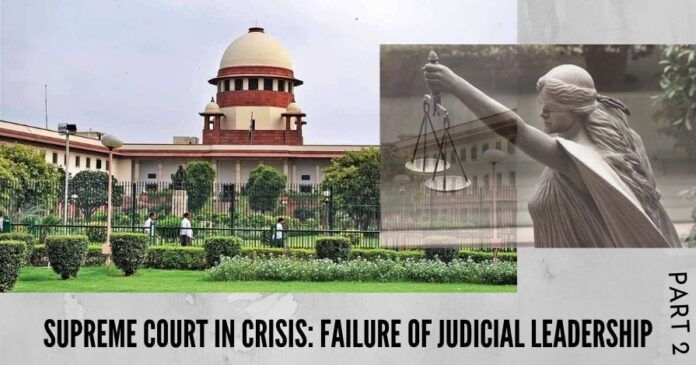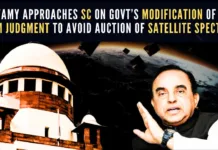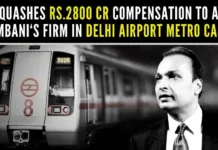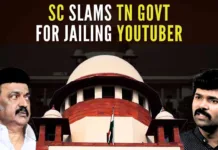
The previous part of this article can be accessed here.
Registry
The legal business markets that we have discussed , function in the Supreme Court on the shoulders of an administration called the Registry. The registry employees are privy to what the Supreme Court judges and it’s Chief Justice do daily in the name of the rule of law, from the allocation of cases to various judges, to the decision making and the passing of orders processes in the court and at the residence. Who comes and meets the judges where, for how long in connection with what matter, to whom the judges talk to or refuse to talk to ,where do the judges go for how long and for what purpose, how the judge and his family behave towards them, what demands the judges seek to be served by the registry, the dictation of judgment and orders as also the daily life cycle of a judge, is automatically known to registry employees. These employees become the repositories of truth about the judges. But woe betides the employee who conscientiously tells the judge most humbly that s/he should be acting in another manner in terms of the impact of a contemplated action or worse for a specific reason an order or decision is ill-considered, contradictory or simply incorrect in fact or law.
No effort whatsoever has been made in the Supreme Court to enforce the Judicial Code of Conduct or Values accepted at the All India Chief Justices Conference.
Consequently a judge who bases judgments on a cut and paste approach, who writes page after page of irrelevance, who uses research without acknowledging the author or the source from which the material is put in the judgment or indulges in any other activity which patently negates what a judge is supposed to stand for, becomes an entity acting on the naked power of the office and title of being a judge. An environment of brute judicial power replaces one of thought, rationality and humility. The silent message that floats is that the employee or the law clerk, in the interest of his job, bury his tongue and conscience, put a permanent smile on his face and simply mind his own business entirely in his own economic interest. The vocabulary, of course, is that the employees must behave so, in the interest of the very institution that they are serving. That logically explains why a staff association of the highest court instead of seeking a fair inquiry for its staff, publicly announces its support to the Chief Justice of India, as if the staffer is right or wrong on the basis of the number of votes for or against, without any fair, just and a reasonable inquiry.
Such is the weight of the judicial air,inherited from the British times of Indians as subjects than as citizens, and continued consciously by our Constitution, that brilliant and upright judges from the district judiciary on deputation to the Supreme Court registry, live in the pain of knowledgable silence till the time that they are allowed to go back to their parent court. Their lips are sealed because of the absolute and total control of their careers by the high courts whose judges, in turn, are absolutely and totally under the control of the Supreme Court collegiums for transfers and elevation to the Supreme Court. I can never forget the painful cry of a distinguished intellectual judge telling me “I don’t know whom to please’’, after he had been tossed around for elevation to the apex court, before ultimately reaching it. The registry as the administrative manager of the Supreme Court, since independence, has been constituted of a top layer of district judges on deputation and lower layers of recruited employees. Their performance and promotion are not public, as seen in the rebuff given by the Supreme Court, to the right to information. So is the recruitment, performance and promotion of peons, drivers and such other staff. There is an urgent need of a public audit of human resource hiring and management in the Supreme Court and the high courts, as the registry can make or mar the fate of a case at the threshold itself. Why?
Firstly, because of what has happened to the lateral entrants to the highest court from the armed forces and academics. Secondly, because the way the district judiciary has been treated, even though this is the only wing of the Indian judiciary selected on the basis of a public exam and an aptitude cum attitudinal interview. There is no point in asking for an All India Judicial Service without opening the path for them on a publicly known merit and integrity, right till the opportunity of being a Supreme Court judge. Otherwise, an All India Judicial Service simply widens the absolute and totally opaque control of the high courts over the district judiciary without informing the public of the results of the mandatory inspections of the district judiciary conducted by the high courts and the consequent action taken on these. The spiral of such control and management continues upwards in the increasing administrative control of the Supreme Court of the high courts, formally and informally. A Sabyasachi Mukharji, ultimately the Chief Justice of India, who gave a disciplined rebuff to a Supreme Court trying to control his calendar as a judge of the Calcutta high court, is hard to find today in the environment of fear stemming from absolute power combined with opaqueness in judicial management today.
Thirdly, the treatment that meritorious IT and MBA professionals have received in the Supreme Court and the high courts. MBA court managers and IT professionals have been defanged in using their abilities, to tell the truth to the courts which have employed them. Instead, there was the public phenomenon in Vigyan Bhawan, New Delhi, of a puisne Supreme Court judge mouthing the ruling party’s political slogan to conclude his speech about the technical committee on digitization headed by him, in a wholly unnecessary public expenditure on the inauguration of the Supreme Court’s proposed digitization programme.
Digitisation and electronic missions in the judiciary have to be understood in this context of the increasing distance between court technology and justice. A specific project formulated by the academics hired by the court for pinpointing and resolving tells that, a particular court in a district the problem of criminal cases pending for more than ten and then five years, on the basis of the national judicial data grid data, gathers dust in the Supreme Court. No effort whatsoever has been made in the Supreme Court to enforce the Judicial Code of Conduct or Values accepted at the All India Chief Justices Conference. This has been effectively torpedoed by the judgment of a bench presided over by a Chief Justice of India, Indira Jaisingh vs Registrar General Supreme Court, by holding that no action can be taken against a judge on the basis of this non-statutory Code.
People do not need a law to know what is right and what is wrong. They need the law and an enforcing judiciary to support the call of their conscience as to what is right or wrong.
Much earlier the IIM Ahmedabad, hired by the Supreme Court concerning workflow and arrears, not surprisingly, concluded that nothing can be done till the judges discipline themselves. Truly so, for judicial time paid for by the public, can be spent upon inaugurations, seminars, lectures, judicial diplomacy, domestic and foreign travel from inaugurating an extension of a court building to foreign moot courts, without any public accountability of what the people of India have gained in the bargain. Or judicial time can be spent in doing judicial work, meaningful judicial management, actually rendering legal services to the poor through the total judicial control on publicly funded legal aid. The reaction of a Chief Justice of India to the IIM report’s conclusion was as to how can IIM earn money from us and write this against us. The complete lack of public accountability in the spending of public money in the use of judicial time, court management, judicial behaviour inside and outside the court, only adds to the environment of absolute power and consequent fear. It is this judicial culture which explains why the Supreme Court increasingly seems to have become a court of declaration of fundamental rights instead of their enforcement as required specifically by Article 32 of the Constitution, which creates the fundamental right to approach the Supreme Court directly for the “enforcement” of a fundamental right of human freedom and dignity based on freedom from fear and accountability for these freedoms, that constitute the rule of law. Again the Supreme Court declared in Russell Joy vs Union of India, (2018)3SCC179 the fundamental right to be free from fear without doing anything to enforce it.
This lack of accountability is extended to vital cases involving the national interest and the national exchequer. In the White industries arbitration case the Indian Government had to pay several million dollars after losing the international arbitration against this Australian Company for the delay caused in the Indian Courts. The award clearly stated that the solicitor general of India had told the arbitral tribunal that he had nothing to say. But then did he travel to London to tell the arbitral tribunal only this? An Indian Supreme Court judge, enraged at the remarks by the international arbitral tribunal about the delay in India’s courts, went public with the cry of the award being a “threat to national security”. But the Supreme Court never thought it fit to suo moto enquire as to the role of the then Solicitor General and the then Union Law and Finance Ministers. Judicial unaccountability slips to national financial and legal unaccountability. Yet, judges of the Supreme Court went about publicly speaking at legal seminars about this judgment, carefully avoiding any mention to this part of the tribunal’s statement recording the role of the then Solicitor General.
The last but crucial element in this overall national judicial culture spawned by the Supreme Court is the resistance of a group of judges, advocates on record, younger senior advocates, retired judges and academics who have internally and sometimes publicly tried to stem the grave consequences of such culture. A study of the correlation between retired judges and their post-retirement commissions, tribunal appointments, public and private rich arbitrations could yield startling results on judicial, political and business alignments. But then the resistance group judges advocates and academics are kept at arm’s length from the Supreme Court collegiums and are treated as hostile vectors on a loose run, not knowing what is good for them. The silence of the retired Chief Justices of India, law firms, media-savvy academics, retired law officers, is telling. These represent two cultures of two India. Judicial management of sexual harassment within the judiciary represents one culture in which it is not thought fit that minimally the Chief Justice of India should go on leave till there is a fair just and reasonable inquiry by an impartial body both in fact and law. The choice is between a fearful culture which demands respect because of the post or title with absolute command over resources and results or culture of earning respect by being publicly responsible, responsive and accountable to rid people of fearing in doing the right. People do not need a law to know what is right and what is wrong. They need the law and an enforcing judiciary to support the call of their conscience as to what is right or wrong. Which culture carries the day will determine the happiness quotient of the people of India and a Supreme Court that shows how to uphold constitutional morality in a political economy that promises to be murkier with fintech.
The twin present challenges of Supreme Court crisis are an opportunity to restructure the judicial system by being realistic, rational and open for making the rule of law meaningful with a judicial leadership aligned to earning and not merely commanding respect, in the background of its contempt power. The Supreme Court can quickly start this by publicly acknowledging its own judges who are scholarly but silent servers of justice for the poor and lead the Bar to this end. Internally driven reform preserves and protects independence.
Note:
1. The views expressed here are those of the author and do not necessarily represent or reflect the views of PGurus.











It was reported that P.Chidambaram today got “bail” for 25th consecutive time!!!! Please verify! May be a guiness book of world record of sorts speaks volumes………
To repeat that cliche, “… but who will bell the cat?” Modi knows he will not be able to do it because the oppn. will not cooperate with him on anything he does. He also knows this is not a vote-winner. Assuming he wins, maybe he can make Jaitley the Law Minister and ask him to clean up the top court. It does not matter Jaitley won’t succeed. At least, he won’t be Fin Min.
Please elaborate on
1.incident of J Sabyasachi Mukherjee when he was judge of Calcutta HC??
2. a Puisne Supreme Court judge mouthing slogan of ruling party??
3.Solicitor General of India in arbitration in London??
In one word whole country is for sale. Judiciary, media, politicians, and the executive branch
The whole country as Churchill said is run by scoundrels and Debauchers. Starting with Nehru and Gandhi. I am ashamed of these Judges. Bastards should be shot on the road. God save the country
Excellent